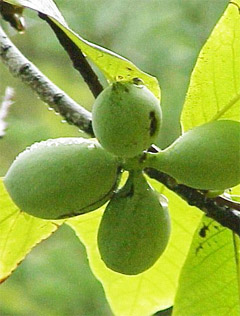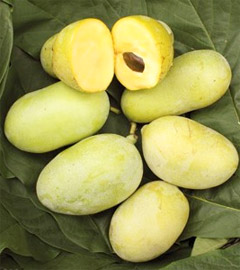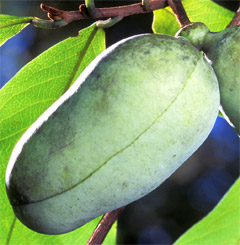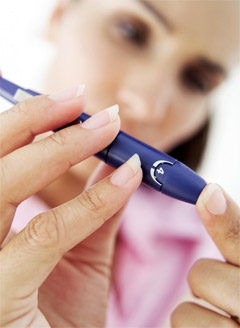|
|
|
 , ,
Font size |
Paw Paw: An Anti-Cancer Fruit From USA

A little-known native of the eastern United States, paw paw fruit has
yellow-green skin and soft, orange flesh with a creamy, custard-like consistency
and a delicious, sweet flavor.
These qualities have earned it the nickname "custard apple," but it also goes by
"poor man's banana" and "Indiana banana."
The paw paw tree (Asimina triloba) is indigenous to 26 states in the United
States, growing wild from the Gulf Coast up to the Great Lakes region. It's a
favorite host plant of the zebra swallowtail butterfly, whose larvae feed on the
leaves.
Historically, the fruit was enjoyed by Native Americans and early European
settlers alike. At least two U.S. presidents favored paw paws: George Washington
reportedly enjoyed them for dessert, and Thomas Jefferson was known to have
grown paw paws at Monticello.
Today the paw paw, which often grows along the banks of rivers and streams, is a
convenient snack for kayakers and a staple in the autumn diets of many country
dwellers.
Paw paw aficionados eat the fruit straight from the tree, or use it in a variety
of delicious recipes. Paw paw ice cream, anyone? How about paw paw-nut bread?
But despite this fruit's popularity with locals and its rich nutritional value
(it's high in protein, antioxidants, vitamins A and C and several essential
minerals), the pawpaw has managed to stay out of most grocery stores and off the
radar of big agriculture. The odd beanlike shape and mottled skin of the pawpaw
make it a hard sell to consumers who don't know the custardy sweetness that lies
beneath the fruit's exterior. And the pawpaw doesn't travel well: It bruises
easily and has a short shelf life (two to three days at room temperature).
So if you want to give paw paws a try, don't run to the supermarket. Instead,
look for this fruit at farmer's markets and specialty stores � including some
online retailers � in the late summer or early autumn. If you're a
do-it-yourselfer, you can purchase your own pawpaw trees and start harvesting
these fruits within a few years. As a native of the United States, it has few
pests and doesn't need much care.
But be forewarned that the pawpaw's maroon blossom, while beautiful, is said to
smell like rotting meat � which might further explain its delayed cultivation.
Asimina is a genus of eight species of small trees or shrubs with large simple
leaves and large fruit, native to eastern North America, collectively referred
to as Pawpaw. The genus includes the widespread common pawpaw Asimina triloba,
which bears the largest edible fruit indigenous to the continent.The common
pawpaw is a patch-forming (clonal) understory tree found in well-drained, deep,
fertile bottomland and hilly upland habitat. Pawpaws are in the same plant
family (Annonaceae) as the custard-apple, cherimoya, sweetsop, ylang-ylang and
soursop; the genus is the only member of that family not confined to the
tropics.
The genus name Asimina was first described and named by Michel Adanson, a French
naturalist of Scottish descent. The name is adapted from the Native American
name assimin through the French colonial asiminier. The common name pawpaw, also
spelled paw paw, paw-paw, and papaw, probably derives from the Spanish papaya,
perhaps because of the superficial similarity of their fruits.
 The fruit of the common pawpaw is a large edible berry, 5�16 cm (2�6 in) long
and 3�7 cm (1.5�2.5 in) broad, weighing from 20�500 g (1�18 oz), with numerous
seeds; it is green when unripe, maturing to yellow or brown. It has a flavor
somewhat similar to both banana and mango, varying significantly by cultivar,
and has more protein than most fruits. The fruit of the common pawpaw is a large edible berry, 5�16 cm (2�6 in) long
and 3�7 cm (1.5�2.5 in) broad, weighing from 20�500 g (1�18 oz), with numerous
seeds; it is green when unripe, maturing to yellow or brown. It has a flavor
somewhat similar to both banana and mango, varying significantly by cultivar,
and has more protein than most fruits.
The leaves, twigs, and bark of the common pawpaw tree contain natural
insecticides known as acetogenins.
Fresh pawpaw fruits are commonly eaten raw; however, they do not store or ship
well unless frozen. The fruit pulp is also often used locally in baked dessert
recipes, with pawpaw often substituted in many banana-based recipes. Pawpaws
have never been cultivated for fruit on the scale of apples and peaches, but
interest in pawpaw cultivation has increased in recent decades. However, only
frozen fruit will store or ship well. Other methods of preservation include
dehydration, production of jams or jellies, and pressure canning.
The pawpaw is also gaining in popularity among backyard gardeners because of the
tree's distinctive growth habit, the appeal of its fresh fruit, and its
relatively low maintenance needs once established. The common pawpaw is also of
interest in ecological restoration plantings since this tree grows well in wet
soil and has a strong tendency to form well-rooted colonial thickets.
Health Benefits of Paw Paw fruit
There are a very broad range of health benefits to the pawpaw, but they also
tend to cause allergic reactions, so care should be taken when using them.
PawPaw can help to combat cancer. In fact, the pawpaw extract, when used to
combat cancer cells, can actually cause the cancer cells to die. A chemical in
pawpaw which is called acetogenin was very effective in combating cancer of
several types.1,2,4
Pawpaw is a natural method of killing pests. In dissertations from 2003, the
extract which is taken from the bark of the pawpaw can kill mosquitos. It also
kills shrimp when tested and even the extract from a very small twig can
accomplish this. Pawpaw is not toxic to humans so the extract is being studied
and considered as a non toxic method of killing pests on growing plants. In
fact, pawpaw extract is so effective that they can be used to treat lice and are
nearly 100 percent effective at treating the problem.3
Pawpaw can help to control your blood sugar. Diabetic mice were tested using
asimina extract or not treatment at all. In the mice who had received the pawpaw
extract, their blood sugar went down even after eating a meal and in addition,
the pawpaw extract also helped to lower their blood sugar.5
Pawpaw can lower cholesterol. The extract of pawpaw or the consumption of the
fruit can help to combat high cholesterol. High cholesterol is one of the number
one causes of heart disease and stroke.
Pawpaw has been used in homeopathy.
 The fruit of this tree is reputed to have anti-cancer properties. One Purdue
University professor, Dr. Jerry L. McLaughlin, spent two decades studying this
fruit and its chemical constituents, acetogenins. His research and the
subsequent research of others that followed, have validated the pawpaw fruit's
use as a safe and effective herbal anti-cancer therapy. That said, no herbal
therapy should be used in place of proper medical care, nor should it be used
without a doctor's knowledge and supervision. The fruit of this tree is reputed to have anti-cancer properties. One Purdue
University professor, Dr. Jerry L. McLaughlin, spent two decades studying this
fruit and its chemical constituents, acetogenins. His research and the
subsequent research of others that followed, have validated the pawpaw fruit's
use as a safe and effective herbal anti-cancer therapy. That said, no herbal
therapy should be used in place of proper medical care, nor should it be used
without a doctor's knowledge and supervision.
In the 1970s, under funding form the National Cancer Institute, McLaughlin, a
professor of pharmacognosy at Purdue University, started studying the
anti-cancer potential of botanical substances from over 3,500 plant species. In
his studies, he discovered a type of long-chain fatty acid called acetogenins
contained in the pawpaw fruit that he found to possess the greatest anti-cancer
potential of all the compounds he'd examined. McLaughlin spent the next 20 years
studying the therapeutic potentials of these pawpaw acetogenins.
Annonaceous acetogenins are complex mixtures of long chain fatty acids
derivatives from the extracts of the twigs of the pawpaw tree. Many of the
acetogenins have been isolated and characterized, and their numerous health
benefits are being explored. Three, bullatacin, asimicin, and trilobacin, have
been identified as the most potent, major, bioactive structural types of
acetogenins in the paw paw concentrate.
Difficulties with most of the chemotherapeutic drugs emanate from their
concurrent eradication of normal healthy cells, including those responsible for
immunity.
Tumor cells grow and replicate more rapidly than normal cells. This is because
they are better equipped to receive glucose, a good source of energy for fast
replication. Also, cancer cells quickly develop a network of blood vessels
(angiogenesis) to ensure an efficient supply of nutrients and oxygen. This is
partly why cancer patients lose weight; the cancer cells rapidly take up
nutrients meant for normal cells.
Furthermore, with chemotherapy cancer cells develop resistance to the drugs,
rendering chemotherapy useless and futile after a period of remission. The same
principle applies to other diseases that have become drug resistant, such as
malaria. The organisms and cancer cells smartly find a way of protecting
themselves from the damaging effects of drugs. They generate what is called the
ABC transporter superfamily, which transports a variety of substrates including
amino acids, sugars, inorganic ions, polysaccharides, peptides, and proteins
into the cells. In cancer cells, a member of this superfamily, called the
multidrug resistant (MDR) protein, is overexpressed and helps to pump drugs out
of the cancer cells, making the cancer cells simultaneously resistant to a
variety of drugs. Thus, the cancer cells are protected from the toxic effects of
drug combinations.
Annonaceous acetogenins may be good chemotherapeutic agents for cancer. These
compounds inhibit mitochondrial and cytoplasmic production of adenosine
triphosphate (ATP), which is the major source of energy for the cells and also a
precursor of the nucleotides needed to produce DNA and RNA. Annonaceous
acetogenins inhibit the enzymes of complex I in the electron transport system in
mitochondria. They also inhibit the NADH oxidases found in the plasma membranes
of tumor cells. Their net effect is depletion of ATP levels.
Tumor cells, being typically metabolically more active, are more susceptible
than normal cells to the effects of the acetogenins. Angiogenesis requires ATP
and angiostatin blocks angiogenesis by inhibiting ATP synthase. Thus, ATP
depletion helps to block the growth of new vessels to nourish tumors. Tyrosine
kinases, which play roles in tumor progression, are also inhibited by ATP
depletion.
Annonaceous acetogenins also thwart MDR tumor cells. The protein pumps (glycoproteins),
which extrude the drugs from the tumor cells are energized by ATP. Thus, by
depleting ATP, the glycoproptein pumps become dysfunctional.
Ongoing studies confirm the benefits of pawpaw extracts in clinical cancer
treatments. Pawpaw extracts can be used to inhibit the growth of cancer cells
and as effective alternative or supplement to chemotherapeutic agents. Research
information suggests that the bioactive compounds in pawpaw will prevent the
growth of cancer cells and shrink tumors. A standardized pawpaw extract, Pawpaw
Cell-Reg, containing mixtures of annonaceous acetogenins is now available.
Research studies also show that pawpaw extracts are antimicrobial, antifungal,
and effective against intestinal worms and head lice.
-
Malaria fever- Squeeze some yellow pawpaw leafs in water. Take
a glassful three times daily for seven days. This preparation is also good
for jaundice. The dosage is the same.
-
 Diabetes- The green leafs of pawpaw are good foe
diabetes-induced hypertension. Squeeze the green leaves in water and take a
glass thrice daily. This preparation is also good for constipation. Diabetes- The green leafs of pawpaw are good foe
diabetes-induced hypertension. Squeeze the green leaves in water and take a
glass thrice daily. This preparation is also good for constipation.
-
Stomach Ulcer- Cut a big unripe pawpaw fruit into pieces. Do
not remove the peel or seeds. Simply cut the whole fruits into cubes. Then
soak in five bottles of water for four days. Sieve and take � a glass thrice
daily for 2 weeks. This is a very good remedy for any type of intestinal
ulcer.
-
External Ulcer- The white milky sap of the unripe pawpaw
contains a high percentage of papain, which is used for chronic wounds or
ulcers. This can be obtained by making a slight cut of the unripe pawpaw
fruit to allow the juice drop. Papain is also present in the ripe pawpaw
fruit.
-
Asthma- Burn dried pawpaw leaves and inhale the smoke during an
attack of asthma. This will bring quick relief. Therefore, to prevent an
attack, inhale the smoke every night.
-
Bronchitis- The root of the pawpaw plant is a good remedy for
respiratory problems especially bronchitis. Bring some pawpaw roots to boil
and take � a glass thrice daily. For cough, simply chew a tender pawpaw root
and swallow the juice.
-
Piles- Pawpaw root is effective for the cure of piles. Prepare
as for bronchitis. The dosage is half a glass twice daily.
-
Impotence- Cut two unripe pawpaw fruits into pieces (seeds and
peel inclusive). Bring to boil in eight bottles of water. Take half glass
thrice daily.
-
For chronic external ulcers or sores, cut a piece of unripe pawpaw
fruit and tie directly to the wound. Do this four times daily. Continue till
the wound has dried, which will be in few days or weeks. To make the wound
heal faster, eat plenty of ripe pawpaw.
-
The ripe fruits are rich in vitamins A, B and C. Vitamin A is good for
eyesight, Vitamin B for the nerves and muscles while Vitamin C strengthens
the immune system and helps fight against illnesses. Form worms, chew 2
tablespoons of the seeds of ripe pawpaw fruit first thing on rising and last
thing at night. Do this for 3 days. Take only fruits for breakfast and
supper for those three days.
Video
Dated 22 March 2014
|
|
|
|
|









